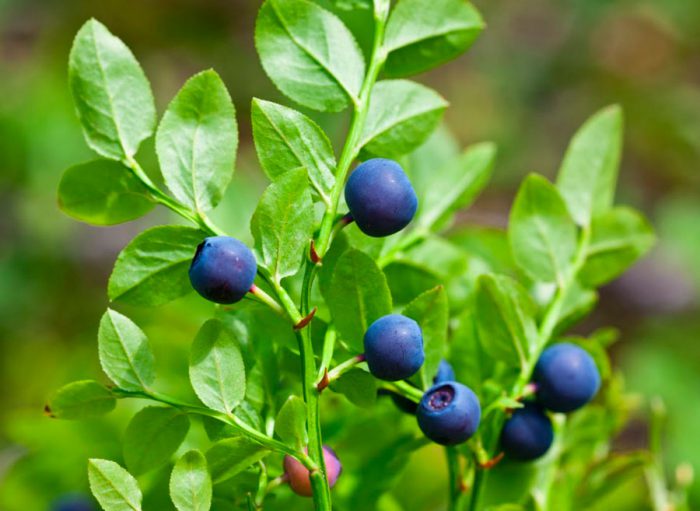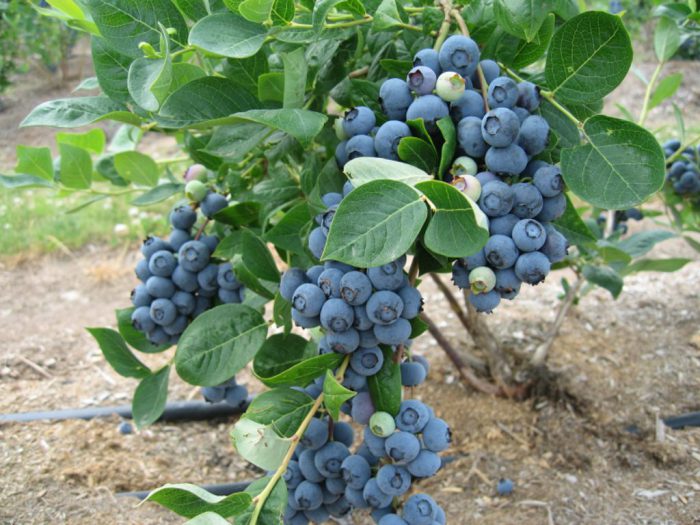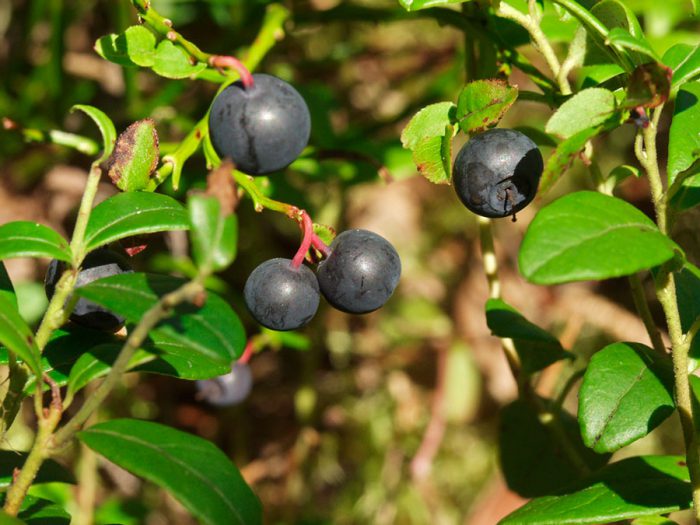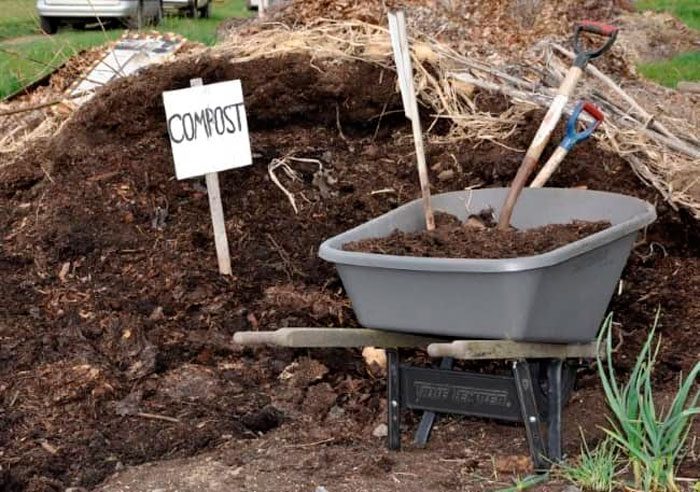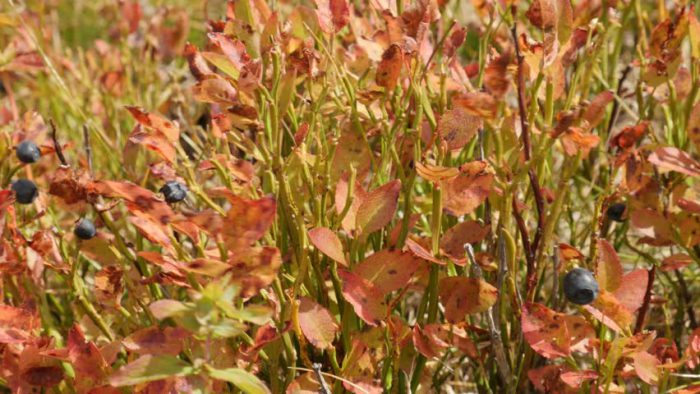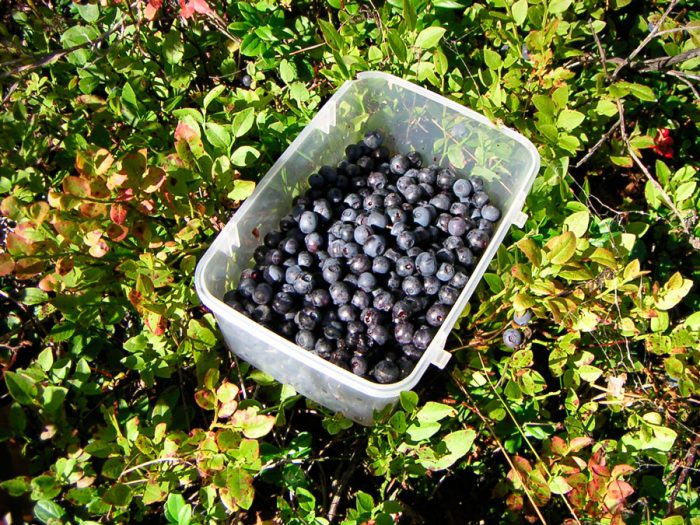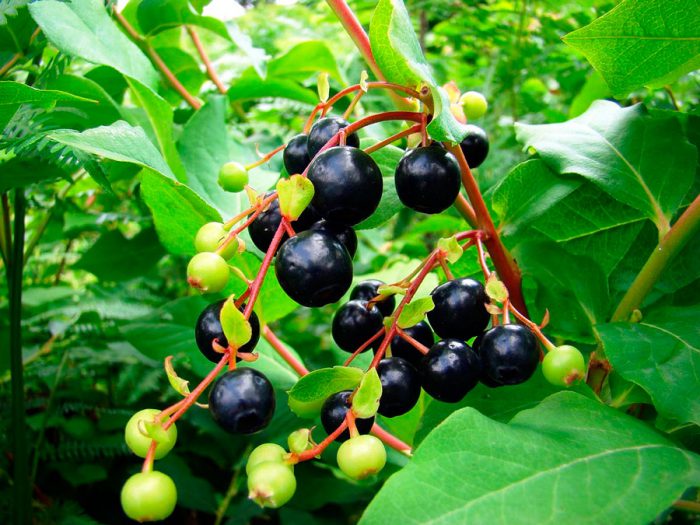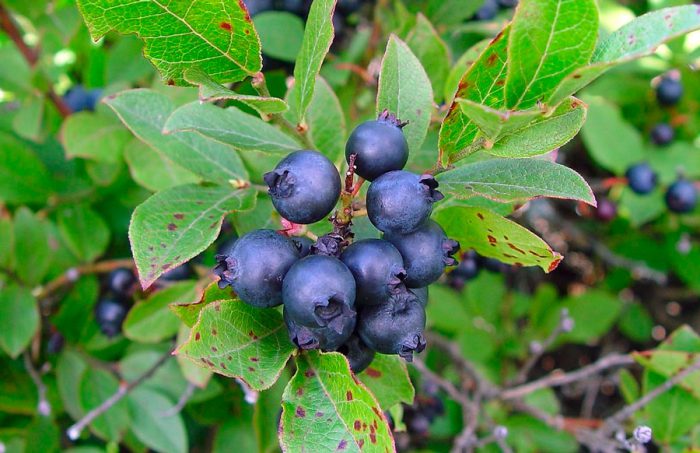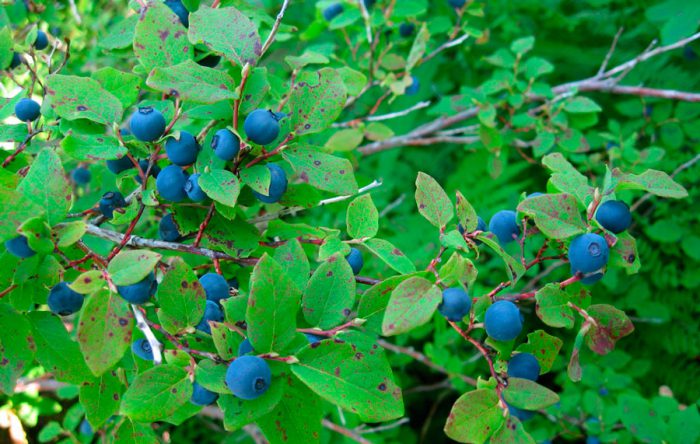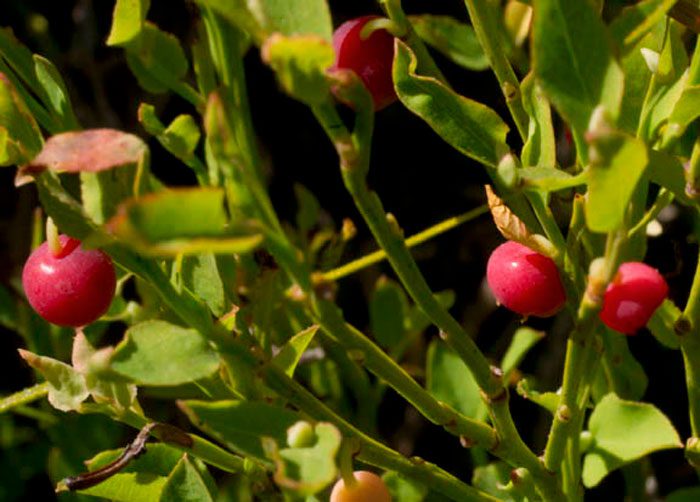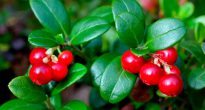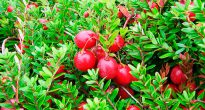Common blueberry (Vaccinium myrtillus), also called myrtle-leaved bilberry, is a stunted plant with edible fruits. This species belongs to the genus Vaccinium, which is a representative of the Heather family (not so long ago, this genus belonged to the Lingonberry family). The name of this genus comes from the Latin word, translated as "cow", the fact is that foliage of some species was used as feed for livestock. And the species was named myrtle blueberry because of its resemblance to the myrtle plant. The Russian name for blueberry is associated with the color of the fruit and juice of this plant, from which the hands and mouth turn black for a long time. In Russia, the plant has other names, for example: chernega, blueberry, blueberry, blueberry or blueberry. The relatives of blueberries are berry crops such as cranberries, lingonberries and blueberries.
Such a plant in natural conditions can be found in the subarctic belt, in the taiga regions of Northern Europe and Asia, and in North America. Blueberries are cultivated both as an ornamental and as a medicinal plant.
Content
Blueberry features
Bilberry is a small deciduous shrub, the height of which can vary from 0.1 to 0.5 m. Sharp, green-colored branches extend from the trunk at an acute angle. Short-petiolate alternately arranged leaf plates of a rounded shape serrated along the edge in spring and summer have a greenish color, which changes to red in autumn. The ground shoot passes into the rhizome, small branchy roots extend from it, which penetrate into the soil by only 50–60 mm. Drooping single pink-green flowers are placed on short pedicels at the base of young branches. The fruit is an egg-shaped or spherical berry with a diameter of 0.6-1 cm and a dark blue color, there is a bluish bloom on the surface. The shrub blooms in May or June, while fruiting is observed from July to September.
Planting blueberries outdoors
The best area for planting blueberries will be the one that is located in shade, under the delicate shade of tall trees. The soil is acidic, while the groundwater should not lie too far from the surface of the site. If such a shrub is planted in a well-lit area, then in this case it will need frequent spraying with water during the day. If the planting of blueberries is carried out in a region with a rather mild and not too long winter, then this procedure is recommended to be carried out in August – September. In middle latitudes and colder regions, the planting of such a crop should be carried out towards the end of the spring period, after return frosts are no longer observed.
If several bushes are planted at once, then a distance of 150 cm should be observed between them.If there are aisles, then their width should be at least 250 cm.The size of the planting hole should be 0.6x0.6 m, and the depth should be 0.8 m. At the bottom of the pit, it is necessary to make a drainage layer; for this, broken brick or expanded clay is used.
Most often, the soil in the garden is not very acidic, so you need a special soil mixture to plant blueberries. To do this, in the process of preparing the planting pit, the upper nutrient layer of the soil should be thrown aside. It is combined with peat (2: 1), and powdered sulfur is added to acidify, while a quarter of a teaspoon is taken for 1 bush. To fix the excessively heavy soil, rotted oak foliage or river sand is introduced into it. With this dredge, it is necessary to completely fill the pit prepared for planting, then wait 7-15 days, during which time the soil in the pit should have time to settle. In this regard, the preparation of the planting pit must be started 20-30 days before planting blueberries.
Experienced gardeners recommend purchasing two-year or three-year-old seedlings for planting. Carefully examine the planting material, the fact is that instead of blueberry seedlings, you can be sold blueberries, since these crops are very similar to each other. Before planting a plant, it is necessary that its earthy clod is saturated with water. Before planting blueberries, the soil in the pit must be shed with acidified water (1 small spoonful of citric acid for 10 liters of water), 1 bucket of mixture is taken for 1 hole. Then the surface of the soil must be loosened and a hole made in it. In this hole, a plant root system should be placed, which is very neatly straightened, while an earthen lump must be loosened. The well must be filled with an acidified earth mixture. When the plant is planted, the soil around it should be tamped, and the shrub itself needs abundant watering. When water is absorbed into the soil, its surface should be covered with a layer of mulch (sawdust or loose leaves).
If seedlings are planted that are more than 3 years old, then when they are planted, their branches are shortened to 20 centimeters. This will allow the blueberries to take root faster and better in their new location.


Watch this video on YouTube
How to care for blueberries
Watering
In order for blueberries to grow and develop normally, they will need to be systematically watered. On average, the plant is watered once every 2 weeks. If there is a prolonged drought and heat, then the number of irrigations should be increased. Remember that the soil under the bush should always be slightly damp. Once every 4 weeks, water intended for irrigation must be mixed with oxalic, citric or acetic acid. With watering, you need to be extremely careful, if stagnation of water is observed in the soil, this can cause the development of fungal diseases. In this regard, it is recommended not to use a large amount of water for irrigation, but to cover the surface of the site with a four-centimeter layer of mulch (leaves, sawdust or needles). This measure will help reduce the amount of watering.
Fertilizer
For feeding this shrub, both mineral fertilizers and organic matter are used.It is recommended to take peat crumbs, rotted manure or compost as organic fertilizers for such a crop. Organic matter needs to be applied once every 3 years in autumn, while from 3 to 4 kilograms is taken per 1 square meter of the plot. Fertilizing with mineral fertilizers is carried out every year, while not very large amounts of a solution of ammonium sulfate, superphosphate and potassium magnesium are introduced into the soil. Remember that such a plant reacts extremely negatively to chlorine, so it should not be present in the fertilizer.
Also, such a shrub responds well to foliar top dressing with microelements. The plant is sprayed in the evening, when it will no longer be hot outside.
Pruning
They begin to cut blueberries from three to four years of age. Pruning is carried out at the beginning of the spring. The bony growths that appear, as well as diseased and weak branches should be removed from the bush. Ideally, one shrub should have 7 to 9 stems completely healthy and well developed. In order for the branches on such stems to be strong and powerful when they reach the age of four, they need to be cut to 20 centimeters. You should also cut out lateral shoots with buds, which grow a lot, since they give small and late berries. Rejuvenating blueberry pruning will be needed after she turns 15. To do this, all branches of the bush must be cut to 20 centimeters from the ground surface. If the plant is cut correctly and regularly, then a good harvest of useful fruits is guaranteed to you.
If the shrub is cultivated in the garden as an ornamental, then by cutting the plant, it can be given any desired shape.
Wintering
Frost-resistant blueberries do not need to be covered for wintering, as winter frosts are not terrible for them. However, one should beware of recurrent frosts in spring, as they can destroy blueberry flowers. Therefore, you need to have on hand a covering material that will help protect the bushes in case of the threat of recurrent frosts.
Diseases and pests
This plant has a fairly high resistance to pests and diseases, but in some cases it also gets sick. Scabbards and aphids often settle on such a shrub. Such sucking insects suck the plant sap from the stems and leaf plates of the plant. To destroy such pests, insecticides are used, for example: Aktara, Aktellik and Inta-Vir. For prophylaxis, in the autumn, after all the leaves fall off, the surface of the area where blueberries grow is freed from plant residues that need to be destroyed. In early spring, the bushes are sprayed with Karate for prevention.
Blueberries can also be infected with fungal diseases such as miscospereliosis, rust, and even gray mold. If black and red spots appear on the surface of the leaf plates, then the bush is affected by miscospereliosis. Such a plant looks like it was splashed with mud. If blueberries are infected with rust, then dark brown specks form on the foliage, and due to gray mold, the berries are mummified. In order to cure the shrub, they use such fungicides as: Fundazol, Topsin-M or Bordeaux mixture. Early disease can be cured with one treatment. If the disease is started, then several sprays may be needed.
The greatest danger to blueberries is represented by viral diseases: red ring spot, necrotic spot, dwarfism, filamentous branches and mosaic. To date, such diseases have not yet been learned to cure, in this regard, infected bushes need to be removed from the soil as soon as possible and burned.
Blueberry picking and storage
How to assemble by hand
The collection of blueberries is carried out at the peak of their usefulness, and this time falls in mid-July. In the forest, such shrubs grow in lowlands with marshy ground. However, the first fruits ripen on bushes growing on the edges of forests and clearings.
You can collect fruits only from those bushes that are no more than 15 years old. The fact is that in the berries of such bushes there is the largest amount of medicinal substances, and it is in them that the benefits of such a culture lie. The age of a shrub growing in natural conditions can be determined by the number of side shoots on it. You need to pick the berries in dry weather, and in the morning or evening. Only absolutely healthy, ripe and not injured fruits should be plucked, the color of which should be dark blue, almost black. Berries should be placed in plastic containers or wicker baskets.
Harvesting blueberries with a combine
To harvest the crop 3 or 4 times faster, you can use a harvester called a fruit picker, which looks like a scoop. Its price is low; therefore, this device is in demand in those regions where picking blueberries is a serious seasonal business. This device consists of a box in which a "comb" is attached to the bottom wall, which has sufficiently long bent teeth, the distance between which is from 0.5 to 0.6 cm. The stems, foliage and branches of the plant easily pass between the teeth, while the fruits fall into the container. Such devices can be plastic, metal or wood, and the teeth are made of wire. This harvester, if desired, can be made by hand.
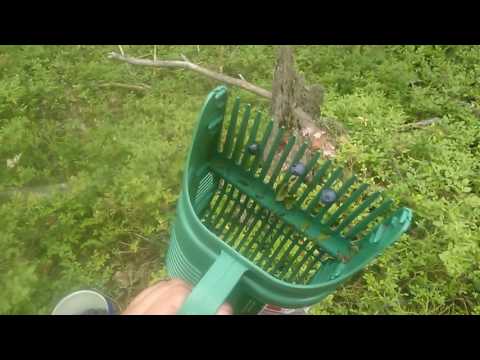

Watch this video on YouTube
Storing blueberries
The collected blueberries must be sorted out, while removing the leaves, unripe berries, stalks, branches and other debris. To do this, the fruits must be poured into a bucket that is filled with water. Ripe berries go down, but the garbage floats up. But this method does not allow you to remove all the garbage, so you still have to sort out the fruits with your hands. You can make jam from blueberries, and berries are also dried or frozen.
For drying, the fruits should be spread in a thin layer on a sheet, which is placed in an oven or oven. The berries are dried at a temperature of 40 to 50 degrees until they are completely dry, while they must be systematically mixed. To store such blueberries, they use wicker containers or containers made of cardboard or wood; they are placed in a dry and dark place.
Wash and dry the berries, then spread it in 1 layer on a tray and put it in the freezer. If the tray is made of metal, cover it with a kitchen paper towel, as it is not recommended that the blueberries come into contact with the metal. After 2-3 hours, the fruits should freeze completely. Remove the frozen fruit and place it in a zipper bag, close the zipper tightly and store the blueberries in the freezer. These blueberries should be used within 12 months.
In order for the crop to be stored for more than 1 year, it must be washed and dried. Then the berries are poured into glass jars, previously calcined in the oven for several hours. Next, the cans are sealed with corks, which must be filled with wax. For storage, jars are removed in a dark and cool place.
Types and varieties of blueberries with photos and descriptions
Gardeners cultivate only specific blueberries, the fact is that this shrub does not yet have a single variety. As a rule, sellers give out blueberries for blueberry varieties, but these are completely different cultures, albeit related to each other. This confusion is due to the fact that both of these plants in English are referred to by the same word - blueberry.
The following types of blueberries are most commonly grown by gardeners:
Hairy blueberry (Vaccinium hirtum)
The homeland of this species is Japan and Sakhalin, it prefers to grow on the outskirts of swamps, as well as in coniferous and mixed forests. The height of such a deciduous shrub can reach up to 100 centimeters. Green leaf plates have an oblong-ovoid shape, pointed towards the apex. In autumn, the color of the foliage changes to carmine. The diameter of the globular black-blue fruits is about 0.5-0.7 cm.
Caucasian blueberry (Vaccinium arctostaphylos)
This plant is considered a relic of the Tertiary period. In nature, it can be found in the northern regions of Asia Minor, the Caucasus, northern Iran and in certain regions of Bulgaria. This species is represented by a large deciduous shrub or tree, the height of which is about 200-300 cm. The leaf plates are large. The fruits are edible and are as popular as the common blueberries. This species is not very frost-resistant.
Narrow-leaved blueberry (Vaccinium angustifolium)
Or Pennsylvania blueberry, a plant native to eastern North America. The height of such a low-growing shrub does not exceed 50 cm. The color of the foliage is green. Highly resistant to frost. Rarely cultivated in mid-latitudes.
Blueberry oval (Vaccinium ovalifolium)
In nature, this species can be found on the Aleutian, Commander and Kuril Islands, on Sakhalin, in Japan and North America. This slow-growing plant reaches a height of 3 to 4 meters. It does not bloom and is not hardy.
Panicle bilberry (Vaccinium scoparium)
This species can be found in nature in the following states of North America: California, Carolina, Alabama and Colorado. The height of such a dwarf shrub does not exceed 0.2 m, it does not differ in high frost resistance. Ripening of berries on such a plant is not observed every year.
Blueberry properties: harm and benefit
Useful properties of blueberries
Fruits contain antioxidants, and this is the main benefit of blueberries. Also, these very useful substances are included in blackberries, apples, red cabbage, radishes and dark grapes, but blueberries contain much more of them than in the listed products. And the foliage and fruits of such a plant contain magnesium, phosphorus, potassium, selenium, zinc, calcium, sulfur, chlorine, sodium, iron, copper, organic acids, vitamins C, B1, B2, B4, B5, B6, PP, A , pectins, saponins, glycosides and other useful substances.
The fruits are distinguished by antihelminthic, antimicrobial and fixing effect. The carotenoids in berries help improve night vision, which is why pilots from England ate large amounts of blueberry jam and fresh berries during World War II. Blueberries are also included in the diet of astronauts.
It has been known for a long time that these fruits enhance vision, increase its fields, and also help to reduce eye fatigue. Not so long ago, scientists found out that these berries help to accelerate the renewal of the retina, and even improve its blood supply. To restore vision, it is recommended in the morning on an empty stomach half an hour before meals to eat 1 large spoonful of fresh or dried fruits (they need to be placed in a container filled with cold water for swelling in the evening).
The fresh juice squeezed from the berries is used to lubricate eczema, skin rashes, and scaly lichen. Compresses can be made from such juice for purulent wounds, weeping eczema, burns or ulcers, they need to be replaced 3 or 4 times a day. Instead of fresh juice, you can use a thick blueberry broth; for its preparation, you need to combine 500 ml of boiling water with 100 grams of dry berries. The mixture should boil until its volume is reduced by ½ part.


Watch this video on YouTube
Harm
It is forbidden to eat blueberries for people suffering from pancreatic diseases and those whose duodenal function is impaired. It is also impossible for those who have individual intolerance, as well as with oxalaturia. Dry berries are not recommended for constipation.

